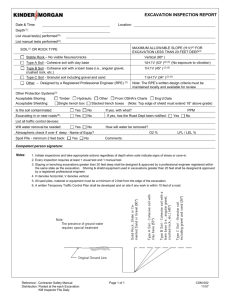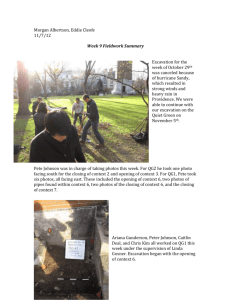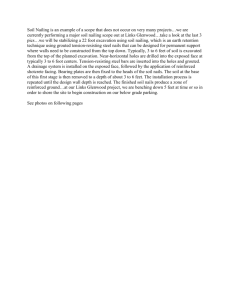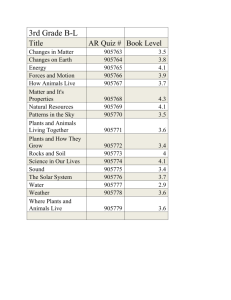to the Excavation Quiz
advertisement
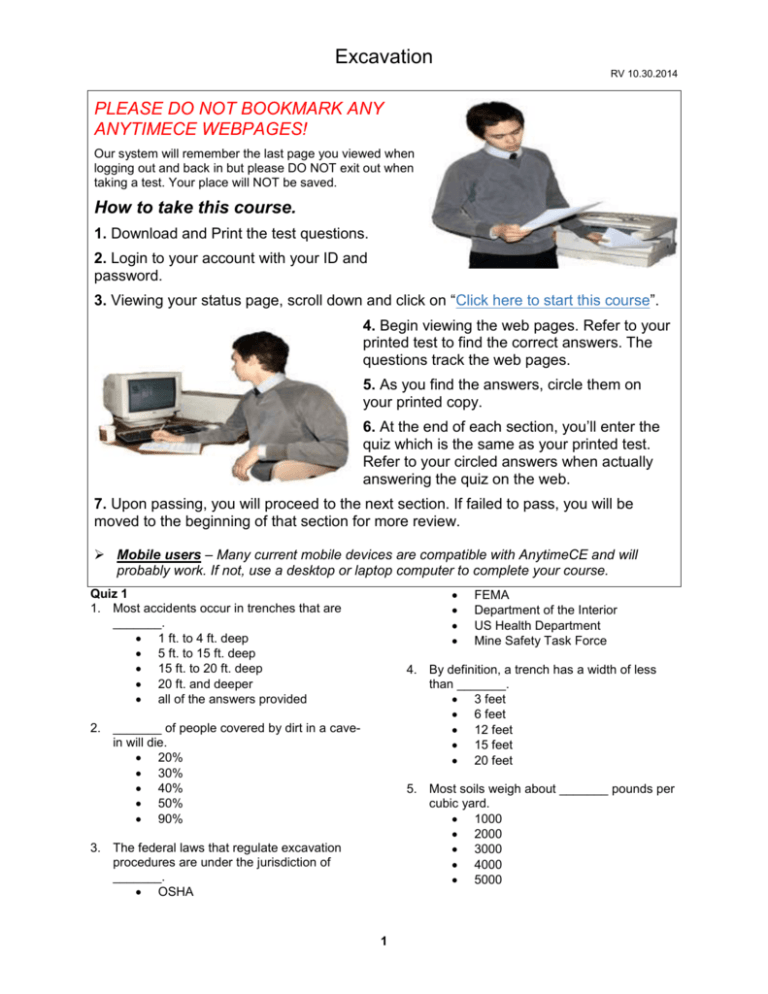
Excavation RV 10.30.2014 PLEASE DO NOT BOOKMARK ANY ANYTIMECE WEBPAGES! Our system will remember the last page you viewed when logging out and back in but please DO NOT exit out when taking a test. Your place will NOT be saved. How to take this course. 1. Download and Print the test questions. 2. Login to your account with your ID and password. 3. Viewing your status page, scroll down and click on “Click here to start this course”. 4. Begin viewing the web pages. Refer to your printed test to find the correct answers. The questions track the web pages. 5. As you find the answers, circle them on your printed copy. 6. At the end of each section, you’ll enter the quiz which is the same as your printed test. Refer to your circled answers when actually answering the quiz on the web. 7. Upon passing, you will proceed to the next section. If failed to pass, you will be moved to the beginning of that section for more review. Mobile users – Many current mobile devices are compatible with AnytimeCE and will probably work. If not, use a desktop or laptop computer to complete your course. Quiz 1 1. Most accidents occur in trenches that are _______. 1 ft. to 4 ft. deep 5 ft. to 15 ft. deep 15 ft. to 20 ft. deep 20 ft. and deeper all of the answers provided FEMA Department of the Interior US Health Department Mine Safety Task Force 4. By definition, a trench has a width of less than _______. 3 feet 6 feet 12 feet 15 feet 20 feet 2. _______ of people covered by dirt in a cavein will die. 20% 30% 40% 50% 90% 5. Most soils weigh about _______ pounds per cubic yard. 1000 2000 3000 4000 5000 3. The federal laws that regulate excavation procedures are under the jurisdiction of _______. OSHA 1 Excavation RV 10.30.2014 6. Soil consists of the following major parts except _______. pebbles sand clay silt Performing a sedimentation test 13. Which of the following is a manual soil test? Thumb penetration Pocket penetrometers Sedimentation All of the answers provided 7. Type A soil has an unconfined compressive strength of _______. greater than 1.5 tons per square foot greater than 0.5 and less than 1.5 tons per square foot greater than 0.1 and less than 0.5 tons per square foot at least 1750 Torvanes 14. A penetration of 1/4” would indicate _______. solid rock a Type A a Type B a Type C a Type D 15. Following a brief rainstorm, the soil must be retested. True False 8. Type A soil _______. (check all that apply) may be fissured may be subject to vibration may be previously disturbed may have water present none of the answers provided 16. To accurately determine the amount of silt in soil, the following _______ test should be performed. thumb penetration pocket penetrometer sedimentation wet thread ribbon 9. Type B soil has an unconfined compressive strength of _______. greater than 1.5 tons per square foot greater than 0.5 and less than 1.5 tons per square foot between 0.1 and 0.5 tons per square foot at least 1750 Torvanes at least 2.1 on the Richter Scale Quiz 2 1. Cave-ins usually give a warning prior to happening. True False 10. Type C soil is the most cohesive soil. True False 2. Typical soil that is 5 feet in height will exert approximately _____ pounds per square foot in a sideways direction at the base of the soil. 100 150 200 250 500 11. The person on the job site who is responsible for soil testing is called _______. the responsible person an idiot the competent person the incompetent person 3. Which of the following is a standard description of a cave-in? Sliding Toppling Subsidence and bulging Boiling All of the answers provided 12. During a visual test, which of the following is NOT done? Checking for tension cracks Checking for previously disturbed soil Checking for indications of layered geologic structuring 2 Excavation RV 10.30.2014 4. Which is/are the most common reason(s) for a trench collapse? Moisture in the soil, too much or too little Soil previously disturbed Soil has repeated freezing and thawing All of the answers provided whaler screw jack Dinah Shore 7. A support or shield should extend a minimum of _______ above the surrounding soil. 12 inches 16 inches 18 inches 24 inches 36 inches Quiz 3 1. Generally, excavations less than _____ in depth don’t require a protective system. 4 ft. 5 ft. 6 ft. 8 ft. none of the answers provided 8. The maximum depth an excavation can be dug without a professional engineer designing the system is _______. 10 ft. 15 ft. 20 ft. 25 ft. no limits 2. Which of the following is a method for excavation protection? Sloping Benching Shoring Trench shield All of the answers provided 9. A trench shield can be stacked on each other. Yes, always Yes, but only if it is designed for "double stacking" Yes, if the competent person says so No, never allowed No, the shield can never be greater than 8 feet in depth. 3. Type C soil may have a slope not exceeding ______ degrees. 53 45 34 22-1/2 15 Quiz 4 1. The major problem with water in a trench is _______. that the soil quickly loses structural strength the workers cannot clearly see the bottom of the trench and may slip the workers can drown in deep water the workers’ boots and clothes become wet and can increase the chance of pneumonia the electrical shock hazard increases 4. Benching is NOT allowed for which of the following types of soil? Type A Type B Type C Type D All of the answers provided 5. Spoils shall be placed no closer than _______ from the edge of the excavation. 1 ft. 2 ft. 3 ft. 4 ft. none of the answers provided 2. Prior to entering a trench, which of the following should be tested? Oxygen level Combustible gas Hazardous substances All of the answers provided 6. Currently, a popular method of shoring is _______. hydraulic timber 3 Excavation RV 10.30.2014 3. A ladder, stairway or ramp is needed if the excavation is more than ______ in depth. 3 ft. 4 ft. 5 ft. 6 ft. 8 ft. 4. Ladders shall be spaced so that workers don’t need to travel more than ______ in lateral distance. 10 ft. 15 ft. 20 ft. 25 ft. 50 ft. 5. Ladders shall extend ______ above the edge of the trench. 1/2 ft. 1 ft. 2 ft. 3 ft. 4 ft. 6. On the job site, employees must wear hard hats. True False Quiz 5 1. On a guard rail, the upper rail must be ______. between 42 to 45 inches between 36 to 42 inches between 36 to 48 inches between 40 to 46 inches 4
